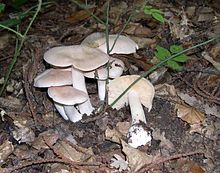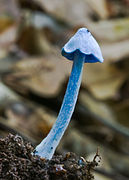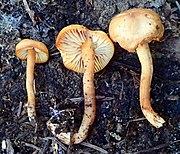
The Agaricales are an order of fungi in the division Basidiomycota. As originally conceived, the order contained all the agarics, but subsequent research has shown that not all agarics are closely related and some belong in other orders, such as the Russulales and Boletales. Conversely, DNA research has also shown that many non-agarics, including some of the clavarioid fungi and gasteroid fungi belong within the Agaricales. The order has 46 extant families, more than 400 genera, and over 25,000 described species, along with six extinct genera known only from the fossil record. Species in the Agaricales range from the familiar Agaricus bisporus and the deadly Amanita virosa to the coral-like Clavaria zollingeri and bracket-like Fistulina hepatica.

The Strophariaceae are a family of fungi in the order Agaricales. Under an older classification, the family covered 18 genera and 1316 species. The species of Strophariaceae have red-brown to dark brown spore prints, while the spores themselves are smooth and have an apical germ pore. These agarics are also characterized by having a cutis-type pileipellis. Ecologically, all species in this group are saprotrophs, growing on various kinds of decaying organic matter. The family was circumscribed in 1946 by mycologists Rolf Singer and Alexander H. Smith.

Entoloma is a genus of fungi in the order Agaricales. Called pinkgills in English, basidiocarps are typically agaricoid, though a minority are gasteroid. All have salmon-pink basidiospores which colour the gills at maturity and are angular (polyhedral) under a microscope. The genus is large, with almost 2000 species worldwide. Most species are saprotrophic, but some are ectomycorrhizal, and a few are parasitic on other fungi. The type, Entoloma sinuatum, is one of several Entoloma species that are poisonous, typically causing mild to severe gastrointestinal illness.

Rhodocybe is a genus of fungi in the family Entolomataceae. Basidiocarps are agaricoid producing pink basidiospores that are unevenly roughened or pustular under the microscope. Species are saprotrophic and mostly grow on the ground, occasionally on wood. The genus is distributed worldwide.

The Hymenogastraceae is a family of fungi in the order Agaricales with both agaric and false-truffle shaped fruitbodies. Formerly, prior to molecular analyses, the family was restricted to the false-truffle genera. The mushroom genus Psilocybe in the Hymenogastraceae is now restricted to the hallucinogenic species while nonhallucinogenic former species are largely in the genus Deconica classified in the Strophariaceae.

Melanoleuca is a poorly known genus of saprotrophic mushrooms traditionally classified in the family Tricholomataceae. Most are small to medium sized, white, brown, ocher or gray with a cylindrical to subcylindrical stipe and white to pale yellowish gills. The basidiospores are ellipsoid and ornamented with amyloid warts. Melanoleuca is considered a difficult group to study due to their macroscopic similarities among species and the need of a thorough microscopic analysis to separate species. DNA studies have determined that this genus is closely related to Amanita and Pluteus and that it does not belong to the family Tricholomataceae.

Phaeocollybia is a genus of fungi in the family Hymenogastraceae. They are characterized by producing fruit bodies (mushrooms) with umbonate caps and rough brown spores. The genus is widely distributed, and contains about 50 species. They are known for a long stipe which continues down into the ground, known as a rooting stipe or pseudorhiza formed as the fruitbody grows up from the subterranean colonized roots well below the organic soil layer. The genus is primarily mycorrhizal but may also be somewhat parasitic on forest trees.
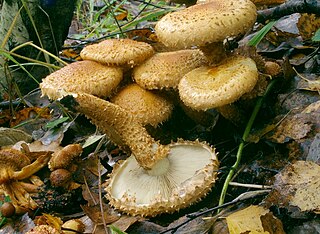
Pholiota is a genus of small to medium-sized, fleshy mushrooms in the family Strophariaceae. They are saprobes that typically live on wood. The genus has a widespread distribution, especially in temperate regions, and contains about 150 species.

Pseudoomphalina is a genus of fungi in the placed in the family Tricholomataceae for convenience. The genus contains six species that are widespread in northern temperate areas. Pseudoomphalina was circumscribed by Rolf Singer in 1956. Pseudoomphalina was found to be paraphyletic to Neohygrophorus in a molecular phylogenetics study and since Pseudoomphalina is an older name, Neohygrophyorus was synonymized with it. The type species of Neohygrophorus was Neohygrophorus angelesianus, now Pseudoomphalina angelesiana. In earlier classifications based on anatomy prior to DNA sequence-based classifications, its unusual combination of features led taxonomists to independently create two subgenera in two genera: Hygrophorus subg. Pseudohygrophorus and Clitocybe subg. Mutabiles; the latter based on Neohygrophorus angelesianus but described under a new species name which is now placed in synonymy, Clitocybe mutabilis. All species of Pseudoomphalina are united by the presence of clamp-connections in their hyphae, an interwoven gill trama and amyloid spores. Pseudoomphalina angelesiana possesses grey-violaceous pigments that turn red in alkali solutions and lacks filiform, hyphal sterile elements in its hymenium and stipitipellis. These were features used to distinguish it from Pseudoomphalina as a genus, but Pseudoomphalina umbrinopurpurascens possesses these same pigments and the filiform elements of Pseudoomphalina. Molecular phylogenetics studies have also found some former species of Pseudoomphalina to belong in other genera. Pseudoomphalina pachyphylla was moved to its own genus, Pseudolaccaria, and Pseudoomphalina clusiliformis was synonymized with it. Pseudoomphalina flavoaurantia and Pseudoomphalina lignicola were found to belong in Clitocybula. Phylogenetically, Pseudoomphalina is in a tricholomatoid clade but not in the Tricholomataceae.
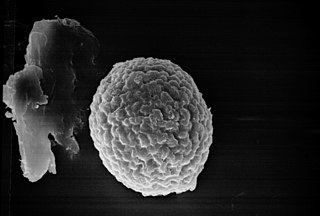
The Tilletiales are an order of smut fungi in the class Exobasidiomycetes. It is a monotypic order, consisting of a single family, the Tilletiaceae, which contains seven genera. The roughly 150 species in the Tilletiales all infect hosts of the grass family, except for species of Erratomyces, which occur on legumes.

Phaeomarasmius is a genus of fungi in the family Tubariaceae. It was formerly thought to belong in the family Inocybaceae. The genus has a widespread distribution, and contains about 20 species.
Clitopilus byssisedoides is a species of fungus in the family Entolomataceae. It was formally described as new to science in 2010, based on specimens found growing in a greenhouse in Botanischer Garten Jena, in Germany.

Rhodocybe gemina is a species of fungus in the family Entolomataceae. It has the recommended English name of tan pinkgill and produces agaricoid basidiocarps that are fleshy and cream when young, becoming brownish when mature.

Mycopan is one of several genera of agaric fungi (mushrooms) that were formerly classified in the genus Hydropus or Mycena. Mycopan is currently monotypic, containing the single species Mycopan scabripes. It produces dusky colored fruit bodies that are mycenoid, but lack amyloid or dextrinoid tissues except for the amyloid basidiospores. Its stipe is notably scruffy from cystidioid end cells and unlike true Hydropus it does not bleed clear fluid. Phylogenetically, Mycopan is distant from the Mycenaceae and the type of that family, Mycena, and it is not with the type of Hydropus, Hydropus fuliginarius. Mycopan grouped closest to Baeospora. Baeospora was shown to be in the Cyphellaceae by Matheny and colleagues. Mycopan scabripes grows from debris in forest floors in North America and Europe.

Entocybe is a genus of agaric fungi in the family Entolomataceae. It was circumscribed in 2011 to contain several former Entoloma species having obscurely angular spores with 6–10 angles. Based on three locus DNA analysis, these species form a distinct, well-defined clade in the Entomolataceae that is basal to Entoloma. The genus name, a combination of Entoloma and Rhodocybe, alludes to similarities with species in those genera. E. melleogrisea, found in a subboreal forest in Québec, Canada, was described as a new species in 2013. Unlike the mostly collybioid fruit bodies of most other Entocybe species, E. melleogrisea has a tricholomatoid stature.
Flammula is a dark brown-spored genus of mushrooms that cause a decay of trees, on whose bases they often fruit, forming clusters of yellowish brown mushrooms.
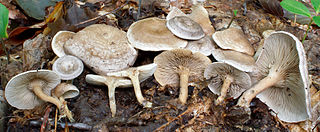
Clitocella is a genus of mushroom-forming fungi in the family Entolomataceae. It was circumscribed in 2014 with Clitocella popinalis as the type species. The generic name refers to its similarities and close relationship to the genera Clitopilus and Clitopilopsis; the Latin word cella, meaning "storage place", alludes to "taxa not belonging to Clitopilus or Clitopilopsis". Species have caps with centrally placed stipes; the gills are decurrent, and crowded closely together with a smooth edge. Mushrooms produce a pink spore print. The spores have thin walls that are cyanophilic and surfaces ornamented with minute bumps that can be seen in profile and face views. This surface ornamentation distinguishes Clitocella from Clitopilus, which has longitudinally ridged spores. Clitopilopsis, in contrast, has thicker spore walls.

Rhodophana is a genus of mushroom-forming fungi in the family Entolomataceae. It originally described as a genus in 1947 by Robert Kühner, but the description was invalid until it was re-published in 1971, though as a subgenus of Rhodocybe. It did not find favour as a genus until Rhodocybe was found to be polyphyletic and Kluting et al. resurrected the name in 2014 as part of a DNA-based reclassification of the family.
